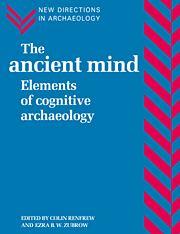Book contents
- Frontmatter
- Contents
- List of figures
- List of tables
- List of contributors
- Preface
- PART I INTRODUCTION
- PART II THE INTERDISCIPLINARY UNDERPINNING
- PART III APPROACHES TO CULT PRACTICE AND TRANSCENDENTAL BELIEF SYSTEMS
- PART IV PREHISTORIC CONCEPTIONS OF SPACE AND TIME
- 10 Symbols and signposts - understanding the prehistoric petroglyphs of the British Isles
- 11 Knowledge representation and archaeology: a cognitive example using GIS
- 12 Dials: a study in the physical representation of cognitive systems
- PART V THE MATERIAL BASIS OF COGNITIVE INFERENCE: TECHNOLOGY
- PART VI THE MATERIAL BASIS OF COGNITIVE INFERENCE: WRITING SYSTEMS
- PART VII CONCLUSION
- Index
12 - Dials: a study in the physical representation of cognitive systems
Published online by Cambridge University Press: 03 December 2009
- Frontmatter
- Contents
- List of figures
- List of tables
- List of contributors
- Preface
- PART I INTRODUCTION
- PART II THE INTERDISCIPLINARY UNDERPINNING
- PART III APPROACHES TO CULT PRACTICE AND TRANSCENDENTAL BELIEF SYSTEMS
- PART IV PREHISTORIC CONCEPTIONS OF SPACE AND TIME
- 10 Symbols and signposts - understanding the prehistoric petroglyphs of the British Isles
- 11 Knowledge representation and archaeology: a cognitive example using GIS
- 12 Dials: a study in the physical representation of cognitive systems
- PART V THE MATERIAL BASIS OF COGNITIVE INFERENCE: TECHNOLOGY
- PART VI THE MATERIAL BASIS OF COGNITIVE INFERENCE: WRITING SYSTEMS
- PART VII CONCLUSION
- Index
Summary
Archaeologists, when reading this chapter, will appreciate that I share with them a peculiar fondness for fine detail even though the details, in this case, do not pertain to material that is ‘archaeological’ in the usual sense. The central issue raised by these details is, however, a critical one that archaeologists share with all students of the activities of our species: how can one use the perceptible human-produced events and objects of the phenomenal world to make inferences about the non-perceptible abilities, meanings, ideas and intentions in the minds of those who produced and used them? Archaeologists typically must face this problem with severely incomplete data, but the problem is, in essence, the same one faced by all other investigators of human culture. It is, in fact, the same problem faced by all human beings in their daily interactions with their fellows. No one has magic access to the mind of others. We do not even have particularly good access to the cognitive processes of our own minds. All anyone - investigator or native - has are artefacts of cognition. Of course there are artefacts of different kinds - a written text is a different kind of artefact from a stone tool; the sound-waves generated by a conversation with a live human being are different again. But none is an open window to the human mind. The trick is to bring as many kinds of data to bear as possible while keeping in mind the weaknesses imposed by the kinds of data that are not available.
- Type
- Chapter
- Information
- The Ancient MindElements of Cognitive Archaeology, pp. 119 - 132Publisher: Cambridge University PressPrint publication year: 1994
- 3
- Cited by

